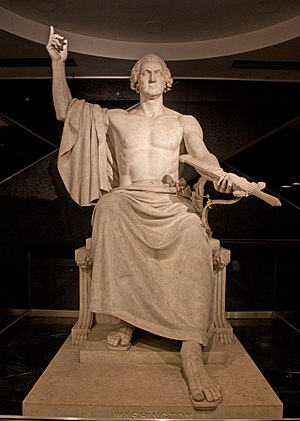George Washington (Greenough)
| George Washington | |
|---|---|
 |
|
| Artist | Horatio Greenough |
| Year | 1832 |
| Type | Carrara marble |
| Dimensions | 3.5 m × 2.6 m (136 in × 102 in × 82 1/2 in) |
| Location | National Museum of American History, Washington, D.C., United States |
| Coordinates: 38°53′28″N 77°01′50″W / 38.89111°N 77.03056°W | |
| Owner | Smithsonian Institution |
George Washington (1840) is a massive sculpture by Horatio Greenough commissioned for the centennial of U.S President George Washington's birth in February 22, 1732.
Horatio Greenough based “Enthroned Washington” on Phidias' great statue of Zeus Olympios which was one of the Seven Wonders of the Ancient World (and which was destroyed in late Antiquity).
The seated and sandal wearing Washington gazes sternly ahead. He is bare-chested and his right arm and hand gesture with upraised index finger toward heaven. His left palm and forearm cradle a sheathed sword, hilt forward, symbolizing Washington turning over power to the people at the conclusion of the American Revolutionary War.
The rear base of the statue features a Latin inscription, which reads:
AD MAGNUM LIBERTATIS EXEMPLUM
NEC SINE IPSA DURATURUM
HORATIUS GREENOUGH
FACIEBAT
The U.S. Congress commissioned Greenough to create a statue of Washington for display in the U.S. Capitol rotunda. When the marble statue arrived in Washington, DC in 1841, however, it immediately generated controversy and criticism. Many found the sight of a half-naked Washington offensive, even comical. The statue was relocated to the east lawn of the Capitol in 1843. Disapproval continued and some joked that Washington was desperately reaching for his clothes, then on exhibit at the Patent Office several blocks to the north. In 1908, the statue was brought back indoors when Congress transferred it to the Smithsonian Castle, where it remained until 1964. It was then moved to the new Museum of History and Technology (now the National Museum of American History). The marble statue has been exhibited on the second floor of the museum since that time.
...
Wikipedia
